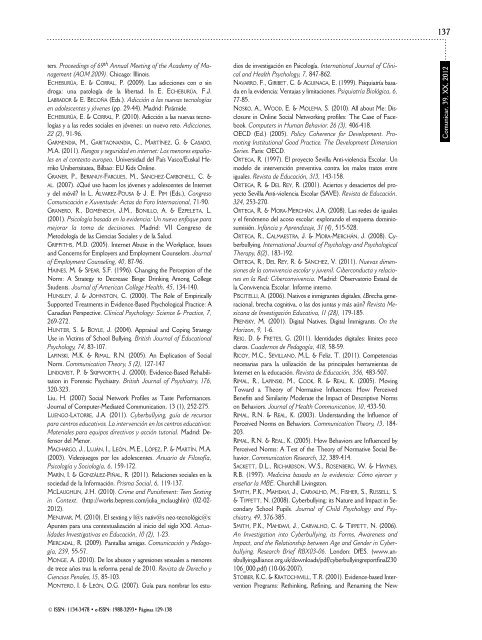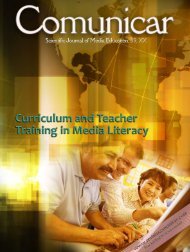Comunicar 39 - Revista Comunicar
Comunicar 39 - Revista Comunicar
Comunicar 39 - Revista Comunicar
You also want an ePaper? Increase the reach of your titles
YUMPU automatically turns print PDFs into web optimized ePapers that Google loves.
137<br />
ters. Proceedings of 69 th Annual Meeting of the Academy of Ma -<br />
na gement (AOM 2009). Chicago: Illinois.<br />
ECHEBURÚA, E. & CORRAL, P. (2009). Las adicciones con o sin<br />
droga: una patología de la libertad. In E. ECHEBURÚA, F.J.<br />
LABRADOR & E. BECOÑA (Eds.). Adicción a las nuevas tecnologías<br />
en adolescentes y jóvenes (pp. 29-44). Madrid: Pirámide.<br />
ECHEBURÚA, E. & CORRAL, P. (2010). Adicción a las nuevas tecnologías<br />
y a las redes sociales en jóvenes: un nuevo reto. Adicciones,<br />
22 (2), 91-96.<br />
GARMENDIA, M., GARITAONANDIA, C., MARTÍNEZ, G. & CASADO,<br />
M.A. (2011). Riesgos y seguridad en internet: Los menores españoles<br />
en el contexto europeo. Universidad del País Vasco/Euskal He -<br />
rriko Unibertsitatea, Bilbao: EU Kids Online.<br />
GRANER, P., BERANUY-FARGUES, M., SÁNCHEZ-CARBONELL, C. &<br />
AL. (2007). ¿Qué uso hacen los jóvenes y adolescentes de Internet<br />
y del móvil? In L. ÁLVAREZ-POUSA & J. E. PIM (Eds.), Congreso<br />
Comunicación e Xuventude: Actas do Foro Internacional, 71-90.<br />
GRANERO, R., DOMÉNECH, J.M., BONILLO, A. & EZPELETA, L.<br />
(2001). Psicología basada en la evidencia: Un nuevo enfoque para<br />
me jorar la toma de decisiones. Madrid: VII Congreso de<br />
Metodología de las Ciencias Sociales y de la Salud.<br />
GRIFFITHS, M.D. (2005). Internet Abuse in the Workplace, Issues<br />
and Concerns for Employers and Employment Counselors. Journal<br />
of Employment Counseling, 40, 87-96.<br />
HAINES, M. & SPEAR, S.F. (1996). Changing the Perception of the<br />
Norm: A Strategy to Decrease Binge Drinking Among College<br />
Students. Journal of American College Health, 45, 134-140.<br />
HUNSLEY, J. & JOHNSTON, C. (2000). The Role of Empirically<br />
Supported Treatments in Evidence-Based Psychological Practice: A<br />
Canadian Perspective. Clinical Psychology: Science & Practice, 7,<br />
269-272.<br />
HUNTER, S. & BOYLE, J. (2004). Appraisal and Coping Strategy<br />
Use in Victims of School Bullying. British Journal of Educational<br />
Psychology, 74, 83-107.<br />
LAPINSKI, M.K. & RIMAL, R.N. (2005). An Explication of Social<br />
Norm. Communication Theory, 5 (2), 127-147<br />
LINDQVIST, P. & SKIPWORTH, J. (2000). Evidence-Based Reha bi li -<br />
tation in Forensic Psychiatry. British Journal of Psychiatry, 176,<br />
320-323.<br />
Liu, H. (2007) Social Network Profiles as Taste Performances.<br />
Jour nal of Computer-Mediated Communication, 13 (1), 252-275.<br />
LUENGO-LATORRE, J.A. (2011). Cyberbullying, guía de recursos<br />
para centros educativos. La intervención en los centros educativos:<br />
Materiales para equipos directivos y acción tutorial. Madrid: De -<br />
fensor del Menor.<br />
MACHARGO, J., LUJÁN, I., LEÓN, M.E., LÓPEZ, P. & MARTÍN, M.A.<br />
(2003). Videojuegos por los adolescentes. Anuario de Filosofía,<br />
Psicología y Sociología, 6, 159-172.<br />
MARÍN, I. & GONZÁLEZ-PIÑAL, R. (2011). Relaciones sociales en la<br />
sociedad de la Información. Prisma Social, 6, 119-137.<br />
MCLAUGHLIN, J.H. (2010). Crime and Punishment: Teen Sexting<br />
in Context. (http://works.bepress.com/julia_mclaughlin) (02-02-<br />
2012).<br />
MENJIVAR, M. (2010). El sexting y l@s nativ@s neo-tecnológic@s:<br />
Apuntes para una contextualización al inicio del siglo XXI. Actua -<br />
lidades Investigativas en Educación, 10 (2), 1-23.<br />
MERCADAL, R. (2009). Pantallas amigas. Comunicación y Peda go -<br />
gía, 2<strong>39</strong>, 55-57.<br />
MONGE, A. (2010). De los abusos y agresiones sexuales a menores<br />
de trece años tras la reforma penal de 2010. <strong>Revista</strong> de Derecho y<br />
Ciencias Penales, 15, 85-103.<br />
MONTERO, I. & LEÓN, O.G. (2007). Guía para nombrar los estudios<br />
de investigación en Psicología. International Journal of Clini -<br />
cal and Health Psychology, 7, 847-862.<br />
NAVARRO, F., GIRIBET, C. & AGUINAGA, E. (1999). Psiquiatría basada<br />
en la evidencia: Ventajas y limitaciones. Psiquiatría Biológica, 6,<br />
77-85.<br />
NOSKO, A., WOOD, E. & MOLEMA, S. (2010). All about Me: Dis -<br />
clo sure in Online Social Networking profiles: The Case of Face -<br />
book. Computers in Human Behavior. 26 (3), 406-418.<br />
OECD (Ed.) (2005). Policy Coherence for Development. Pro -<br />
moting Institutional Good Practice. The Development Dimension<br />
Series. Paris: OECD.<br />
ORTEGA, R. (1997). El proyecto Sevilla Anti-violencia Escolar. Un<br />
modelo de intervención preventiva contra los malos tratos entre<br />
iguales. <strong>Revista</strong> de Educación, 313, 143-158.<br />
ORTEGA, R. & DEL REY, R. (2001). Aciertos y desaciertos del proyecto<br />
Sevilla Anti-violencia Escolar (SAVE). <strong>Revista</strong> de Educación.<br />
324, 253-270.<br />
ORTEGA, R. & MORA-MERCHÁN, J.A. (2008). Las redes de iguales<br />
y el fenómeno del acoso escolar: explorando el esquema dominiosumisión.<br />
Infancia y Aprendizaje, 31 (4), 515-528.<br />
ORTEGA, R., CALMAESTRA, J. & MORA-MERCHÁN, J. (2008). Cy -<br />
ber bullying. International Journal of Psychology and Psycho lo gical<br />
Therapy, 8(2), 183-192.<br />
ORTEGA, R., DEL REY, R. & SÁNCHEZ, V. (2011). Nuevas dimensiones<br />
de la convivencia escolar y juvenil. Ciberconducta y relaciones<br />
en la Red: Ciberconvivencia. Madrid: Observatorio Estatal de<br />
la Convivencia Escolar. Informe interno.<br />
PISCITELLI, A. (2006). Nativos e inmigrantes digitales, ¿Brecha generacional,<br />
brecha cognitiva, o las dos juntas y más aún? <strong>Revista</strong> Me -<br />
xi cana de Investigación Educativa, 11 (28), 179-185.<br />
PRENSKY, M. (2001). Digital Natives, Digital Immigrants. On the<br />
Horizon, 9, 1-6.<br />
REIG, D. & FRETES, G. (2011). Identidades digitales: límites poco<br />
claros. Cuadernos de Pedagogía, 418, 58-59.<br />
RICOY, M.C., SEVILLANO, M.L. & Feliz, T. (2011). Competencias<br />
necesarias para la utilización de las principales herramientas de<br />
Internet en la educación. <strong>Revista</strong> de Educación, 356, 483-507.<br />
RIMAL, R., LAPINSKI, M., COOK, R. & REAL, K. (2005). Moving<br />
Toward a Theory of Normative Influences: How Perceived<br />
Benefits and Similarity Moderate the Impact of Descriptive Norms<br />
on Behaviors. Journal of Health Communication, 10, 433-50.<br />
RIMAL, R.N. & REAL, K. (2003). Understanding the Influence of<br />
Perceived Norms on Behaviors. Communication Theory, 13, 184-<br />
203.<br />
RIMAL, R.N. & REAL, K. (2005). How Behaviors are Influenced by<br />
Perceived Norms: A Test of the Theory of Normative Social Be -<br />
havior. Communication Research, 32, 389-414.<br />
SACKETT, D.L., RICHARDSON, W.S., ROSENBERG, W. & HAYNES,<br />
R.B. (1997). Medicina basada en la evidencia: Cómo ejercer y<br />
enseñar la MBE. Churchill Livingston.<br />
SMITH, P.K., MAHDAVI, J., CARVALHO, M., FISHER, S., RUSSELL, S.<br />
& TIPPETT, N. (2008). Cyberbullying: its Nature and Impact in Se -<br />
condary School Pupils. Journal of Child Psychology and Psy -<br />
chiatry, 49, 376-385.<br />
SMITH, P.K., MAHDAVI, J., CARVALHO, C. & TIPPETT, N. (2006).<br />
An Investigation into Cyberbullying, its Forms, Awareness and<br />
Impact, and the Relationship between Age and Gender in Cy ber -<br />
bullying. Research Brief RBX03-06. London: DfES. (www.an -<br />
tibullyingalliance.org.uk/downloads/pdf/cyberbullyingreportfinal230<br />
106_000.pdf) (10-06-2007).<br />
STOIBER, K.C. & KRATOCHWILL, T.R. (2001). Evidence-based Inter -<br />
vention Programs: Rethinking, Refining, and Renaming the New<br />
<strong>Comunicar</strong>, <strong>39</strong>, XX, 2012<br />
© ISSN: 1134-3478 • e-ISSN: 1988-3293• Páginas 129-138

















